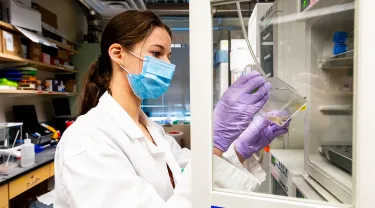Future travelers to Mars will need food that’s nutritious and tasty enough to keep them in peak health for several years—and that’s also easy to grow, store, and prepare with minimal waste.
A Tufts team is developing a promising solution: an alternative version of meat that’s made from cultivated insect cells.
For several years, in order to create meat substitutes as humane and sustainable as plant-based ones, researchers at the Tufts School of Engineering have been making significant contributions to the field of cellular agriculture, creating new ways to grow meat in a lab directly from animal cells. But the latest venture, funded by NASA, represents a new direction: using insects as a source of starter cells.
Insect cells may be a better source of deep-space protein than cultivated mammalian cells, explained Sophie Letcher, a Ph.D. candidate in biomedical engineering who’s working on the project.
Cells from a cow or a pig need to be heated to the temperatures of the animals in which they would naturally grow, while insect cells can be grown at room temperature. Most mammalian cells grown for cultured meat purposes need to be attached to a dish or substrate, which would typically require gravity, but insect cells can more easily grow suspended in a liquid culture media (made up of amino acids, sugar, salts, and other ingredients). “And they've actually already been grown in simulated microgravity,” said Letcher. “That’s a big point of interest.”
The Tufts team with which graduate student Letcher works with is extracting muscle and fat cells, the same types found in a traditional hamburger, said Letcher. How to transform those cells to have the same look, taste, and mouth-feel of familiar meat products is one question the team continues to explore.
